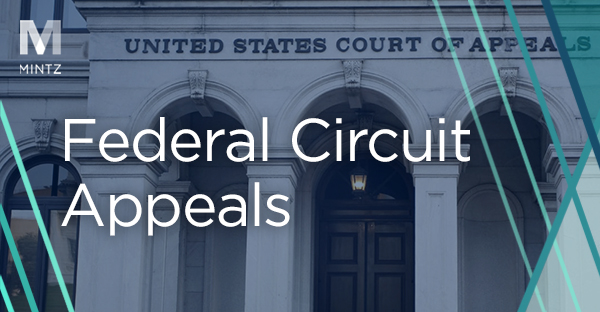
Federal Circuit Appeals
Viewpoints
Filter by:
“Anything Goes” – Federal Circuit Says PTAB Can Use Any Means to Knock Out Substitute Claims (Uniloc v. Hulu: Part 2)
July 29, 2020 | Blog | By Brad M Scheller
Yesterday we discussed the Federal Circuit’s decision in Uniloc 2017 LLC v. Hulu, LLC confirming the Board’s authority to review contingent substitute claims after the original claims have been held invalid by a federal court. Today we cover the panel’s ruling that the Board can use any patentability requirement to evaluate and reject proposed substitute claims in an IPR, notwithstanding that originally-petitioned claims in such proceedings can only be challenged under §§ 102 and 103 based on prior patents and printed publications.
Read more
Dead on Arrival? Federal Circuit Majority Finds That Substitute Claims Live On (Uniloc v. Hulu: Part 1)
July 28, 2020 | Blog | By Brad M Scheller
Last week a Federal Circuit panel in Uniloc 2017 LLC v. Hulu, LLC issued an important decision regarding inter partes review (IPR) before the Patent Trial and Appeal Board on two questions concerning contingent motions to amend—(i) whether the Office has statutory authority to review the patentability of substitute claims after a final federal-court judgement of invalidity of those claims and, if yes, (ii) whether that review of patentability may include analyzing the substitute claims for patent eligibility under 35 U.S.C. § 101.
Read more
Fractured Federal Circuit Panel Finds That Sovereign Immunity Does Not Prevent Exclusive Licensee from Pursuing Unlicensed Infringement Alone
July 28, 2020 | Blog | By Andrew DeVoogd, Daniel Weinger
Entities with patent-related relationships with state universities scored a victory under the rarely implicated (at least for patent practitioners) doctrine of sovereign immunity. For patent holders, sovereign immunity comes into play when a state actor, for example a state university, enters contracts related to patents, such as in Gensetix v. Baylor College of Medicine.
Read more
Federal Circuit: Licensees’ Failure to Mark Eliminates Entitlement to Pre-Suit Damages
July 27, 2020 | Blog | By Adam Samansky, Peter Cuomo, Matthew Karambelas, Courtney Herndon
Recently, in Packet Intelligence LLC v. NetScout Sys., Inc., No 19-2041 (July 14, 2020), the Court of Appeals for the Federal Circuit reversed a jury verdict of $3.5 million in pre-suit damages and vacated the trial court’s enhancement of that award because licensees of the asserted patents failed to properly mark allegedly patent practicing products.
Read more
The Standard May Rule Them All: Federal Circuit Panel Appears Prepared to Find Standard Is Sufficient to Prove Infringement for SEP Compliant Products
July 9, 2020 | Blog | By Michael Renaud, James Wodarski, Daniel Weinger
Recent oral arguments at the Fed Circuit suggest that the U.S. may be taking steps which would enhance its attractiveness for SEP patent holders looking to resolve licensing disputes. The Federal Circuit heard oral argument on Monday, July 6th, in Godo Kaisha IP Bridge I v. TCL Commc’n Tech. Holdings Ltd., No. 19-2215, that may pave an easier path for owners of standard essential patents (“SEPs”) to prove literal infringement of products that comply with that standard.
Read more
Federal Circuit Upholds Application of Dedication-Disclosure Doctrine at the Pleading Stage
May 15, 2020 | Blog | By Thomas Wintner, Adam Samansky, Nana Liu
On May 8, 2020, the Court of Appeals for the Federal Circuit affirmed the District of Delaware’s application of the disclosure-dedication doctrine in granting a motion for judgment on the pleadings in Eagle Pharmaceuticals Inc. v. Slayback Pharma LLC, No. 19-1924.
Read more
Federal Circuit Holds that Accused Infringers that Invalidate Asserted Patents at the PTAB Can Be a Prevailing Party Under Section 285
April 28, 2020 | Blog | By Daniel Weinger, Meena Seralathan
Last week, the Federal Circuit, in a precedential decision, reinforced that an accused infringer can be a “prevailing party” for the purposes of seeking attorneys’ fees under 35 U.S.C. § 285 when it successfully invalidates the asserted patent at the Patent Trial and Appeal Board (“PTAB”).
Read more
Federal Circuit Finds IPRs Can Circumvent Assignor Estoppel
April 27, 2020 | Blog | By Daniel Weinger
On Wednesday, the Federal Circuit held that while assignor estoppel is applicable in district court proceedings, petitions for inter partes review continue to not be subject to the equitable remedy. Assignor estoppel is an equitable doctrine based on the principle of fair dealing that prevents a party who divests a patent from later challenging the validity of that patent.
Read more
PTAB Must Give Parties Notice of Unpatentability Theories when Considering Motions to Amend
April 14, 2020 | Blog | By Daniel Weinger
On Thursday, the Federal Circuit ruled that the Patent Trial and Appeal Board (“PTAB”) must give the parties proper notice if considering a sua sponte theory of unpatentability in relation to a motion to amend.
Read more
Samsung v. Prisua Engineering Corp.: Indefiniteness Rulings Off-Limits for the Patent Trial and Appeal Board
March 5, 2020 | Blog | By Michael Newman, Kevin Amendt
The Court of Appeals for the Federal Circuit ruled in February that the Patent Trial and Appeal Board (PTAB) cannot cancel claims for indefiniteness in an inter partes review (IPR) proceeding. The case is Samsung Electronics America, Inc., v. Prisua Engineering Corp., case number 19-1169, in the U.S. Court of Appeals for the Federal Circuit.
Read more
Understanding Antedating of a Prior Art Reference for a Patent
April 17, 2019 | Blog | By Christina Sperry
The Federal Circuit’s decision in ATI Technologies ULC v. Iancu (April 11, 2019) highlights the proper standard to use in evaluating whether a claimed invention was reduced to practice before the effective date of a prior art reference.
Read more
Written Description in Amgen v. Sanofi: Is the Federal Circuit Possessed? Will SCOTUS Grant Certiorari?
January 2, 2019 | Blog | By John Bauer
In the continuing Amgen v. Sanofi saga, Amgen has asked SCOTUS to take up the issue of written description, which is currently established by showing “whether the disclosure…reasonably conveys…that the inventor had possession of the claimed subject matter as of the filing date.” Ariad Pharms., Inc. v. Eli Lilly & Co., 598 F.3d 1336, 1351 (Fed. Cir. 2010)(en banc)(emphasis added).
Read more
USPTO Implementation of AIA Does Not Violate Due Process: Federal Circuit Affirms the PTAB Panel Determining Institution of an IPR can also Issue the Final Written Decision
January 15, 2016 | Blog | By William Meunier
In Ethicon Endo-Surgery, Inc. v. Covidien LP, a 2-1 panel split of the Federal Circuit held that neither the American Invents Act (“AIA”) nor the Constitution precludes the same panel of the Patent Trial & Appeal Board (“PTAB” or “Board”) from both deciding whether to institute an inter partes review (“IPR”) of a challenged U.S. Patent and making the final patentability determination in that IPR.
Read more
Fed. Cir. Defers to PTAB Finding of Obviousness in First Pharma IPR Reviews (Merck v. Gnosis)
December 21, 2015 | Alert | By Peter Cuomo, Rich Gervase
On December 17, 2015, the Federal Circuit issued a precedential decision affirming a determination by the Patent Trial and Appeal Board (“PTAB”) that patent claims related to methods of treating elevated homocysteine levels were invalid as obvious.
Read more
Determining Damages for Standard Essential Patents: the Federal Circuit Provides Some Guidance in CSIRO v. Cisco
December 7, 2015 | Alert | By Michael Renaud, Sandra Badin
Late last week, in an opinion authored by Judge Prost, a panel of the Federal Circuit vacated a $16 million damages award won by Commonwealth Scientific and Industrial Research Organization (CSIRO) in its patent infringement suit against Cisco Systems, Inc.
Read more
Ninth Circuit Upholds Judge Robart’s RAND Determinations in Microsoft v. Motorola
August 14, 2015 | Alert | By Rich Gervase, Bruce Sokler, Sandra Badin, Michael Renaud
Late last month, the Ninth Circuit Court of Appeals issued its much-anticipated decision in Microsoft v. Motorola, a breach of contract action brought by Microsoft alleging that Motorola violated its commitment to license its standard essential patents (SEPs) on reasonable and non-discriminatory (RAND) terms.
Read more
Biosimilars, the BPCIA, and Amgen v. Sandoz: The Federal Circuit’s First Attempt To Make Sense of “A Riddle Wrapped in a Mystery Inside an Enigma”
July 22, 2015 | Alert | By Thomas Wintner
On July 21, 2015, the Federal Circuit issued a key decision regarding the meaning of various provisions of the Biologics Price Competition and Innovation Act (BPCIA). See Amgen Inc. v. Sandoz Inc., Fed. Cir. Case No. 2015-1499.
Read more
Federal Circuit Invalidates Diagnostic Method Claims for Prenatal Test Under 35 U.S.C. 101
June 24, 2015 | Alert | By Terri Shieh-Newton
On June 12, 2015, the Federal Circuit affirmed the finding of U.S. District Court for the Northern District of California (“District Court”) that the method claims in U.S. Patent 6,258,540 (‘540 patent) for detecting paternally-inherited cell-free DNA (“cffDNA”) in maternal plasma or serum were not directed to patent eligible subject matter, and, therefore, were invalid.
Read more
Supreme Court Upholds Brulotte Rule Prohibiting Post-Expiration Patent Royalties
June 23, 2015 | Alert | By Bruce Sokler, Sandra Badin, Rich Gervase
On June 22, 2015, the Supreme Court issued its decision in Kimble v. Marvel Entertainment, LLC, upholding the rule, first announced in Brulotte v. Thys Co., 379 U. S. 29 (1964), that an agreement allowing a patent owner to collect royalty payments after a patent’s expiration is unlawful per se.
Read more
Second Circuit Holds a Hard Switch Between Drugs Is an Unlawful Product Hop Under Section 2
June 4, 2015 | Alert | By Bruce Sokler
On May 22, 2015, in a much-watched case, the Second Circuit upheld a preliminary injunction against Actavis PLC and its wholly owned subsidiary, Forest Laboratories, LLC (collectively “Actavis” or “Forest”), finding that Actavis’s “hard switch” strategy to launch an extended-release version of its blockbuster Alzheimer’s therapy and delist the immediate-release version would likely violate Section 2 of the Sherman Act.
Read more
Explore Other Viewpoints:
- Data Centers & Digital Infrastructure
- AI: The Washington Report
- Antitrust
- Appellate
- Arbitration, Mediation & Alternate Dispute Resolution
- Artificial Intelligence
- Awards
- Bankruptcy & Restructuring
- California Land Use
- Cannabis
- Class Action
- Complex Commercial Litigation
- Construction
- Consumer Product Safety
- Corporate Governance (ESG)
- Cross-Border Asset Recovery
- DEI Legal Developments
- Debt Financing
- Direct Investing (M&A)
- Diversity
- EB-5 Financing
- Education & Nonprofits
- Employment
- EnforceMintz
- Environmental (ESG)
- Environmental Enforcement Defense
- Environmental Law
- Environmental, Social, and Corporate Governance (ESG)
- FDA Regulatory
- False Claims Act
- Federal Circuit Appeals
- Financial Institution Litigation
- Government Law
- Growth Equity
- Health Care
- Health Care Compliance, Fraud and Abuse, & Regulatory Counseling
- Health Care Enforcement & Investigations
- Health Care Transactions
- Health Information Privacy & Security
- IP Due Diligence
- IPRs & Other Post Grant Proceedings
- Immigration
- Impacts of a New US Administration
- Insolvency & Creditor Rights Litigation
- Institutional Investor Class Action Recovery
- Insurance & Financial Services
- Insurance Consulting & Risk Management
- Insurance and Reinsurance Problem-Solving & Dispute Resolution
- Intellectual Property
- Investment Funds
- Israel
- Licensing & Technology Transactions
- Life Sciences
- Litigation & Investigations
- M&A Litigation
- ML Strategies
- Medicare, Medicaid and Commercial Coverage & Reimbursement
- Mergers & Acquisitions
- Patent Litigation
- Patent Prosecution & Strategic Counseling
- Pharmacy Benefits and PBM Contracting
- Portfolio Companies
- Privacy & Cybersecurity
- Private Client
- Private Equity
- Pro Bono
- Probate & Fiduciary Litigation
- Products Liability & Complex Tort
- Projects & Infrastructure
- Public Finance
- Real Estate Litigation
- Real Estate Transactions
- Real Estate, Construction & Infrastructure
- Retail & Consumer Products
- Securities & Capital Markets
- Securities Litigation
- Social (ESG)
- Special Purpose Acquisition Company (SPACs)
- Sports & Entertainment
- State Attorneys General
- Strategic IP Monetization & Licensing
- Sustainable Energy & Infrastructure
- Tax
- Technology
- Technology, Communications & Media
- Technology, Communications & Media Litigation
- Trade Secrets
- Trademark & Copyright
- Trademark Litigation
- Unified Patent Court (UPC)
- Value-Based Care
- Venture Capital & Emerging Companies
- White Collar Defense & Government Investigations
- Women's Health and Technology




